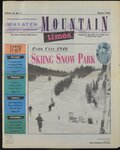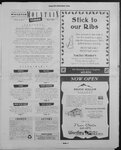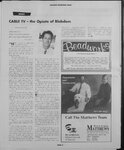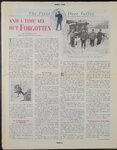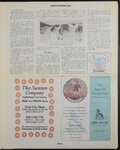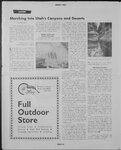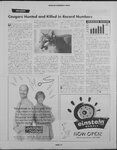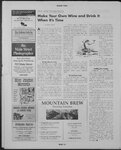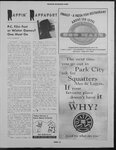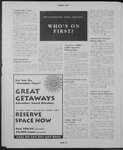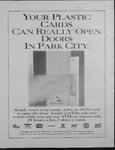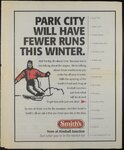| OCR Text |
Show MARCH 1996 Marching Into Utah’s Canyons and Deserts southern sky, warming and thoughts of quiet By Steve Lewis In the badlands between the San Rafael Reef and Capitol Reef National simple forms and solid colors Park, combine in a landscape of barren beauty Smooth wide-open expanse, deep crisscrossed by occasional canyons create moon-like, otherworldly atmosphere. Jet-black stone pinnacles and “goblin” formations add to the effect — Wilderness at the Edge the Utah Wilderness Coalition Lo the snow-capped peaks of the Wasatch and crossing the border into Southern Utah’s Wingate and Navajo sandstone plateaus, reefs, or canyons — on either a hiking or backpacking venture — has always been cause for quiet celebration and excitement. Back home, winter still beckons and neighbors and friends continue to either relax on the slopes or tighten up at the thought of more snow on streets and walkways. But the late winter and early spring sun rises ever higher in the $F myself and scores of other redrock fans on the nearby horizons. The great fun for kids and provides marked Goblin Valley and Temple Mountain South of Green River and North of Hanksville in the southeastern portion trails and numerous park is sightseeing venues. And just to the north, Temple Mountain with its abandoned roadways and mines is also popular with jeepers and historical mining buffs. But once you’ve visited these two sites, the more exciting and wildly shaped and colored terrain is found between Temple Mountain on the north and Goblin Valley to the south in the slots and narrows of Wild Horse Creek, Crack and Chute Canyons and the ever celebrated Little Wild Horse and Bell Canyon terrain. In a sea of constantly changing colors and varied topography, you walk with the wind through these Rock art at Horeshoe Canyon. $¢e¢0 0% HH Ist North HHH HH HHH Full Outdoor Store HOH < canyons, Rafael Swell. HHH 94 West marrow passing sagebrush, greasewood, galleta grass, claret cup cactus and occasional cottonwood, and note you are in bighorn sheep and jackrabbit habitat on the lip of the San Easter recreation crowds and reyeling youth are weeks away. Standing in a high-walled narrows, you rejoice at being alive but wonder whether disclosure of exhilarating hiking, sightseeing and photography opportunities could mar the seclusion sought by so many in their endless quest for quiet and solitude. The Bell and Little Wild Horse Canyon hiking and exploring jaunt is definitely one of the most accessible and best, little narrow canyons on the Colorado Plateau. Plus it’s a fun adventure for the whole family. Years ago, these slots were mostly a secret, but in more recent times by word of mouth the seclusion gave way to much publicity and the canyons became a very busy byway. Visit the place in March though and you'll likely have solitude and near private com- munion with the tight winding walls. Travel there in late spring or fall and the quiet of the canyon gives way to bustling crowds. The word is out: “Grab the gear, Bicycle Service Camping we've got to take the crew up the narrows of Little Wild Horse Canyon.” @ Professional Sales End Rentals @ High Equipment @ Clothing $$$ HHH HHH HHH East of Goblin Valley and Temple $$? HHH HHH $+ OHHHHHHHHHHHHHH C4 of the San Rafael Swell is the popular Goblin Valley State Park with Wildhorse Butte and Temple Mountain marching in the month of March, into all corners of the Colorado Plateau. FH ¢-¢¢% temperatures solitude and primitive recreation in the desert, sends PAGE Mountain are the far western sections of Canyonlands National Park. There you can drive and venture to either Hans Flat and view down into the Maze or travel a bit farther north to the edge of Horseshoe Canyon and then 10 Photos by Steve Lewis Narrows of Little Wild Horse Canyon. hike down into the unique Barrier Canyon-style prehistoric rock art. Horseshoe Canyon Horseshoe is a large winding side canyon, stretching 35 miles north from Hans Flat to Green River. It cuts through Wingate and Navajo sandstone, forming a deep gash in the surrounding grassy benchlands_ interspersed with pinyon, juniper and blackbrush. Park-like vistas on both sides of the canyon feature views to the La Sal Mountains and Book Cliffs. Mule deer, antelope, fox, coyote, and badger reside in the canyons and plateaus, and on the nearby Orange Cliffs, desert bighorn sheep promenade. As you enter the park portion of Horseshoe on foot, you have the opportunity to view some of the most outstanding rock art panels in the southwest. Other surprises greet the exploring hiker as he or she winds through the bows and bends of the .sandy-bottomed canyon. Tributaries along with the main north and south spurs of Horseshoe, outside of the popular rock panel areas, offer remoteness, desert splendor and solitude. If you do march off into the desert in the severe month or of serene March, prepare temperatures for and conditions. Dress accordingly. Plan and prepare. Always retrieve litter and remove evidence of human presence and contact. And in your ventures, please leave the magnificent land and landscape as it is for the next and the next generation. @ — Stephen W. Lewis is a Salt Lake attorney, outdoor enthusiast and canyon conservation activist. |

